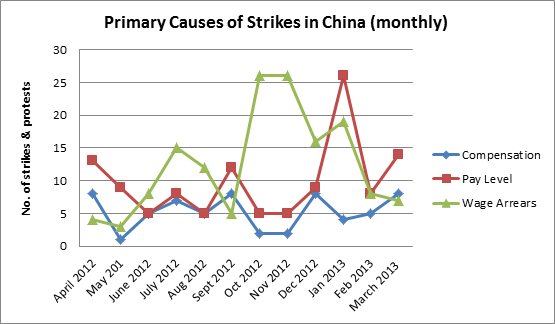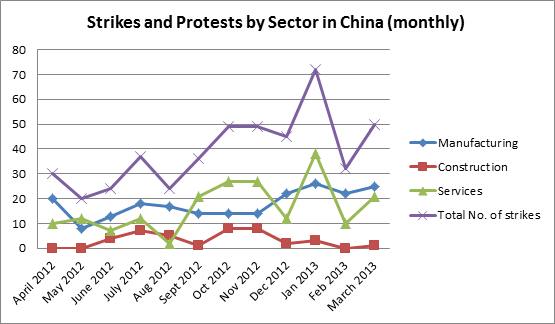By Jennifer Cheung
Despite a sharp drop in inflation last month, workers’ demands for higher pay were still the biggest single cause of the 50 strikes and protests recorded on CLB’s strike map in March. Wage arrears and demands for compensation arising from factory relocations or the severance of contracts were the other major factors in strike action last month. See chart below.

China’s consumer price index fell further than expected to 2.1 percent year on year in March, down from February’s high of 3.2 percent. Food price inflation which had surged to six percent in February because of the Lunar New Year holiday fell back to 2.7 percent.
However, wage levels for many workers are still at an intolerably low level despite the easing of inflation and moves by at least 13 regional governments to increase their statutory minimum wages this year by an average of more than ten percent.
In late March, more than 250 workers in a wide range of jobs in Shenzhen signed a petition complaining that the new minimum wage of 1,600 yuan, which went into effect last month, was still well short of a living wage. They calculated that a decent minimum wage, one which would allow a worker to support their family, would be at least 2, 892 yuan per month, roughly 60 percent of the average monthly wage in Shenzhen.
One of most notable strikes for higher pay occurred on 18 March at the Nanhai Honda automotive plant in Foshan. More than 100 junior workers stopped working in protest at a 10.2 percent pay increase agreed by the management and union. The action forced management to offer a better deal of 14.4 percent the next day and the strikers returned to work.
In a similar dispute at a foreign-owned company in Guangzhou, workers got an additional pay increase after staging a strike in protest at the three percent pay increase offered to ordinary workers. During the one-day negotiations, management agreed to give workers another four percent. In both cases, production line workers were angry at being offered a lower rate of increase than their senior colleagues.
Exactly half of the strikes and protests on the strike map this month (25) occurred in the manufacturing sector but the services sector was not far behind with 21 cases recorded. See chart below.

Teachers across China continued to stage strikes and protests at proposed performance-based pay reforms after students returned from the Lunar New Year holidays. Teachers from middle schools in the Dalian Economic Development Zone protested salary cuts and 300 teachers from a university in Chongqing sung the national anthem to express their dissatisfaction with a new performance review plan. In Sichuan, teachers protested against the local government’s arbitrary deduction of subsidies, and teachers from a middle school in Zhejiang protested against wage arrears. While in Xi’an, 39 kindergarten teachers went on strike against strict management.
There were a total of 11 strikes at state-owned enterprises and public institutions (including schools) in March, with workers mostly protesting against incompetent management, corruption and low salaries. There were eight protests in foreign-owned enterprises, five in Hong Kong or Taiwan-owned factories and seven in domestically-owned private companies.
